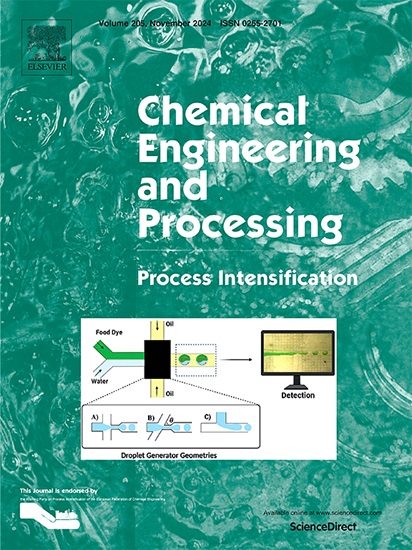Wastewater treatment through a hybrid electrocoagulation and electro-Fenton process with a porous graphite air-diffusion cathode
IF 3.8
3区 工程技术
Q3 ENERGY & FUELS
Chemical Engineering and Processing - Process Intensification
Pub Date : 2025-03-06
DOI:10.1016/j.cep.2025.110258
引用次数: 0
Abstract
Wastewater from hospitals is a major source of pollution, and its treatment to protect the environment is a challenge. Different traditional methods have been applied to treat hospital wastewater (HW). Recently, hybrid processes, such as electrocoagulation (EC) with the electro-Fenton (EF) process, have been found to outperform traditional methods in terms of their high removal rate, low sludge generation and energy consumption and environmental sustainability. Herein, a combined EF process integrated with EC was successfully applied to reduce the chemical O demand (COD) of HW. A batch tubular electrochemical reactor composed of a microporous graphite air diffusion cathode and a hollow cylinder Al anode was used as a new design to remove pollutants from HW. Response surface methodology was adopted to explore the effects of operating factors, which were represented by current density, Fe2+ concentration and time, on COD removal and identify their interactions. The best operating conditions were a current density of 20 mA/cm2, an Fe2+ concentration of 6 mM and a reaction time of 63 min. These conditions yielded a COD removal efficiency (RE %) of 93.5 % with an energy consumption of 18.325 kWh/kg COD. Time had the main effect on the RE % due to the synergistic effect of EC and EF. The hybrid system had higher efficiency and lower energy consumption and sludge production than individual EC or EF. Therefore, combining EC with EF could be a promising approach for the treatment of HW.

采用多孔石墨空气扩散阴极电絮凝-电fenton混合工艺处理废水
医院废水是污染的主要来源,其处理以保护环境是一项挑战。医院污水的处理采用了不同的传统方法。最近,人们发现混合工艺,如电絮凝(EC)与电fenton (EF)工艺,在去除率高、污泥产生少、能耗和环境可持续性方面优于传统方法。在此基础上,成功地应用了EF与EC相结合的组合工艺来降低HW的化学需氧量(COD)。采用微孔石墨空气扩散阴极和空心圆柱形铝阳极组成的间歇式管状电化学反应器,对HW中的污染物进行了去除。采用响应面法研究了以电流密度、Fe2+浓度和时间为代表的操作因素对COD去除率的影响,并确定了它们之间的相互作用。最佳操作条件为电流密度为20 mA/cm2, Fe2+浓度为6 mM,反应时间为63 min, COD去除率(RE %)为93.5%,能耗为18.325 kWh/kg COD。由于EC和EF的协同作用,时间是影响RE %的主要因素。与单独的EC或EF相比,混合系统具有更高的效率和更低的能耗和污泥产量。因此,EC联合EF可能是治疗HW的一种很有前途的方法。
本文章由计算机程序翻译,如有差异,请以英文原文为准。
求助全文
约1分钟内获得全文
求助全文
来源期刊
CiteScore
7.80
自引率
9.30%
发文量
408
审稿时长
49 days
期刊介绍:
Chemical Engineering and Processing: Process Intensification is intended for practicing researchers in industry and academia, working in the field of Process Engineering and related to the subject of Process Intensification.Articles published in the Journal demonstrate how novel discoveries, developments and theories in the field of Process Engineering and in particular Process Intensification may be used for analysis and design of innovative equipment and processing methods with substantially improved sustainability, efficiency and environmental performance.

 求助内容:
求助内容: 应助结果提醒方式:
应助结果提醒方式:


